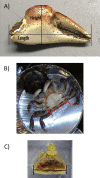Morphometric correlations between dietary and reproductive traits of two brachyuran crabs, Hemigrapsus sanguineus and Aratus pisonii
- PMID: 35925929
- PMCID: PMC9352013
- DOI: 10.1371/journal.pone.0267369
Morphometric correlations between dietary and reproductive traits of two brachyuran crabs, Hemigrapsus sanguineus and Aratus pisonii
Abstract
Many animals have flexible morphological traits that allow them to succeed in differing circumstances with differing diets available to them. For brachyuran crabs, claw height and gut size are diet-specific and largely reflect foraging strategies, while abdomen width reflects relative levels of fecundity. However, the link between claw size and diet has largely been documented only for primarily carnivorous crabs, while the link between diet and fecundity is strong in herbivorous crabs. We sought to determine the nature of the intraspecific relationship between claw size, dietary habits, and fecundity for two primarily herbivorous crab species, Hemigrapsus sanguineus and Aratus pisonii. Specifically, we examined whether claw size and/or abdomen width can be used as reliable measures of individual diet strategy. To test these hypotheses, we collected crabs and measured the dimensions of their claws, abdomens, and guts. By comparing these dimensions for each individual, we found that strongly predictive relationships do not exist between these traits for the primarily herbivorous species in our study. Thus, identifying external morphological features that can be used to assess diets of primarily herbivorous crabs remains elusive.
Conflict of interest statement
The authors have declared that no competing interests exist.
Figures




Similar articles
-
Predicting diet in brachyuran crabs using external morphology.PeerJ. 2023 Apr 10;11:e15224. doi: 10.7717/peerj.15224. eCollection 2023. PeerJ. 2023. PMID: 37065690 Free PMC article.
-
Evidence for use of both capital and income breeding strategies in the mangrove tree crab, Aratus pisonii.Sci Rep. 2021 Jul 16;11(1):14576. doi: 10.1038/s41598-021-94008-8. Sci Rep. 2021. PMID: 34272445 Free PMC article.
-
Morphological and morphometric comparison of the first zoeal stage of the mangrove crabs of the genus Aratus H. Milne Edwards, 1853 (Decapoda: Sesarmidae).Zootaxa. 2015 Apr 24;3949(2):217-28. doi: 10.11646/zootaxa.3949.2.4. Zootaxa. 2015. PMID: 25947803
-
A review of feeding and nutrition of herbivorous land crabs: adaptations to low quality plant diets.J Comp Physiol B. 2007 Apr;177(3):269-86. doi: 10.1007/s00360-006-0138-z. Epub 2007 Feb 6. J Comp Physiol B. 2007. PMID: 17279390 Review.
-
Timing of hatching and release of larvae by brachyuran crabs: patterns, adaptive significance and control.Integr Comp Biol. 2011 Jul;51(1):62-72. doi: 10.1093/icb/icr013. Epub 2011 May 18. Integr Comp Biol. 2011. PMID: 21593141 Review.
Cited by
-
Predicting diet in brachyuran crabs using external morphology.PeerJ. 2023 Apr 10;11:e15224. doi: 10.7717/peerj.15224. eCollection 2023. PeerJ. 2023. PMID: 37065690 Free PMC article.
References
-
- Schmitz OJ, Buchkowski RW, Burghardt KT, Donihue CM. Functional traits and trait-mediated interactions: connecting community-level interactions with ecosystem functioning. InAdvances in ecological research 2015. Jan 1 (Vol. 52, pp. 319–343). Academic Press.
-
- Smith LD. Biogeographic differences in claw size and performance in an introduced crab predator Carcinus maenas. Marine Ecology Progress Series. 2004. Aug 2;276:209–22.
MeSH terms
Associated data
LinkOut - more resources
Full Text Sources

